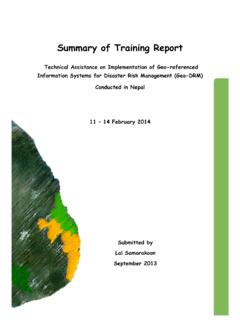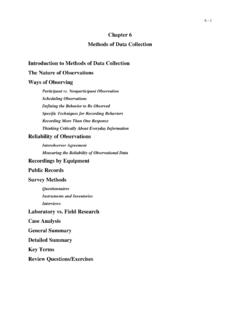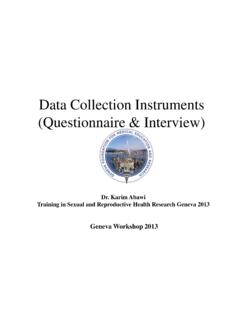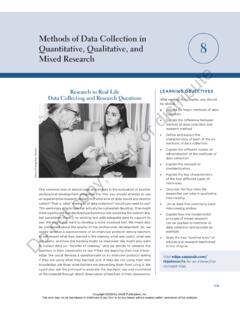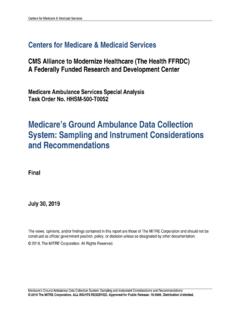Transcription of Data Collection Methods and Instruments - ESCAP
1 WHO/ ESCAP Training Manual on Disability Statistics - 33 - Welded to work Serge Corrieras WHO Photo Contest Images of Health and Disability 2002/2003 Learning Objectives: Chapter 3 data Collection Methods and Instruments After reading this chapter, the reader should be able to: 1. Understand process of disability data Collection . 2. Describe and evaluate population censuses, surveys, and administrative data Collection . 3. Match data Collection tools to disability statistics users needs.
2 WHO/ ESCAP Training Manual on Disability Statistics - 34 - 3. data Collection Methods AND Instruments Measurement of disability Collection Instruments Choice of selection and measurement unit Population censuses Sample surveys As dedicated disability surveys As a module to other sample surveys Administrative collections What is an administrative data Collection ? What are the benefits? How can administrative data be used?
3 Joint use of census and sample survey census screen Strengths and weaknesses of the data Collection Methods Relatable data Measurement of disability Collecting data about persons with disabilities and their lives is difficult. It poses unique problems that data Collection developers need to address in the design phase of the Collection process. Two issues need to be addressed at the outset: what kind of data Collection instrument should be used, and what unit of measurement should be employed.
4 Collection Instruments The main types of Instruments for collecting data about persons with disabilities are: Population censuses Sample surveys (either general social surveys or specific health and disability surveys) Administrative collections and registries Each of these tools can be used to measure aspects of disability in a population and each has its strengths and weaknesses. WHO/ ESCAP Training Manual on Disability Statistics - 35 - The Population Census certainly has the advantage of providing complete population coverage.
5 Unfortunately, it is difficult to collect accurate information about disability in a census since time constraints make it unlikely that more than 4 to 6 general disability questions can be asked. Censuses, in some instances, also undercount children with disabilities and people with mild or moderate disabilities (in cases where the response categories are limited to Yes or No options only). Still, for a crude measure of disability, and in the absence of other Collection Instruments , the census is useful.
6 Sample surveys are shorter surveys designed to be administered to a sub-population selected by some other instrument (often a census) that focus on specific issues. They are often put into the field to answer specific questions about a population. As such, they provide the opportunity to ask more detailed questions about disability. More detailed information is useful in itself, of course, but it also helps to reduce the number of false positive and negative responses, thereby offering a more accurate prevalence measure.
7 A sample survey may be an independent survey focusing entirely on disability, or a disability module added to an existing survey. Administrative collections and registers are composed of data that is collected as part of the normal operation of some service or programme. An example is the information found on a client intake form. These collections provide useful information on the characteristics of people accessing disability services as well as details about the services provided.
8 They cannot give an accurate measure of disability prevalence since there is no guarantee of coverage and they tend to incorporate double counting. The quality of administrative register data is closely related to the quality of the administrative system, in particular, how well it has been maintained and how closely the concepts align with the disability concepts of interest. These three Instruments for gathering disability information are discussed in detail in the rest of this chapter.
9 Choice of selection and measurement unit The second preliminary issue that needs to be addressed, whatever data Collection instrument is chosen, is how to select the unit for which disability is to be measured. If the selection unit is the individual, then the individual will also be the measurement unit; if the selection unit is a Collection of people invariably a household then, a decision has to be made as to whether the measurement unit is the household itself (that is, all individuals in the household) or some individual in the household that meets specified criteria (age, gender, unemployed, and/or others).
10 These decisions depend in part on what kinds of data are needed. Is data required for the number of persons with disabilities and their characteristics, or for an estimate on the number of households that include individuals with disabilities? data about individuals is important, but estimates at the household level are also useful for detailed analysis of living arrangements and access to help and assistance. WHO/ ESCAP Training Manual on Disability Statistics - 36 - There are also issues of practicality and efficiency.
